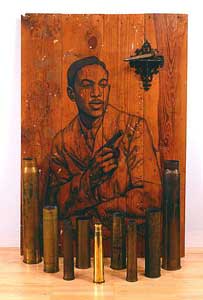Whitfield Lovell at DC Moore
by Kristen Swenson, Art in America

Whitfield Lovell: You’re My Thrill, 2004, charcoal on wood, shell casings, 54 by 36 ½ by 14 inches; at DC Moore.
Artifacts of a bygone era—barn doors, a spinning wheel, tin snips, playing cards, a revolver, a tin cup—are culled by Whitfield Lovell for his tableaux. All are worn smooth by the hands of individuals long dead, for whom these were means of diversion, labor, self-defense or sustenance. Lovell animates the lost narratives embedded in these personal effects with shadowy charcoal portraits based on anonymous studio photographs, some drawn directly on the artifacts, others on aged wood boards. The women are demure and domestic; the men wear military uniforms or dapper suits. We are given ample material through which to imagine their lives—lives shaped by the fact that they were black and living in postbellum America, the same America documented in Jacob Lawrence’s epic “Migration of the Negro.”
Migration is the theme of Train (2006), a tableau of five charcoal portraits on wood foundry molds—circular drums that stood upright on the floor like train wheels, evoking both Northward exodus and the industrial jobs that beckoned. Other tableaux register violence: a dreamy-eyed young man cocking a pistol is depicted on the altarpiecelike panel of You’re My Thrill (2004); arranged in front of it, in place of devotional candles, is a row of gleaming shell casings. Viewers can project different associations—perhaps the segregated units of black soldiers in the First World War, or the blurring of theater and threat that animates the young man’s performance of Wild West machismo.
Art-historical associations are extensive too, ranging from Lawrence to Robert Rauschenberg’s combines to Walker Evans’s vacant interior photographs of a “negro barbershop” or laborers’ homes. Like Evans, Lovell lets surroundings tell their stories.
The grimy cupboard topped with a humble place setting and ancient radio speaker conveys the travails and aspirations of the loving couple painted onto a board above it in a tableau called Destiny (2006). Chance, luck, one’s lot in life—however it is understood, destiny is captured with startling economy in Lovell’s “Card Pieces,” (2003-06) installed in a side gallery. These spare collages pair a charcoal portrait, also based on an anonymous studio photograph, with a timeworn playing card.
Lovell’s work is “self-consciously African American,” as Henry Louis Gates said of Lawrence’s, in an essay in which Gates also called visual art “a central means by which African Americans could achieve a profound understanding of themselves.” Despite his adherence to vintage images and objects, Lovell’s art is distinctly contemporary: the century-old image of a young man flaunting a pistol also reads as a hip-hop icon. Lovell’s tableaux summon volumes of history, and art history, with their unresolved juxtapositions.
